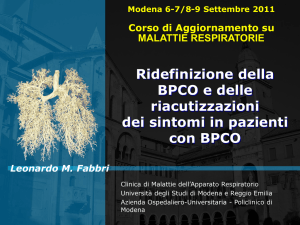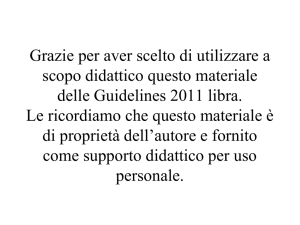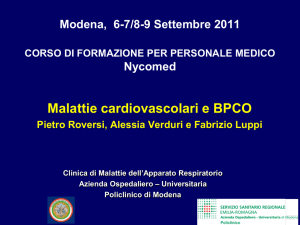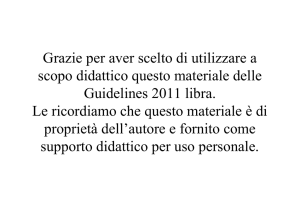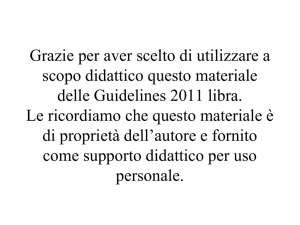Non-pharmacological approach to comorbidities in
advertisement
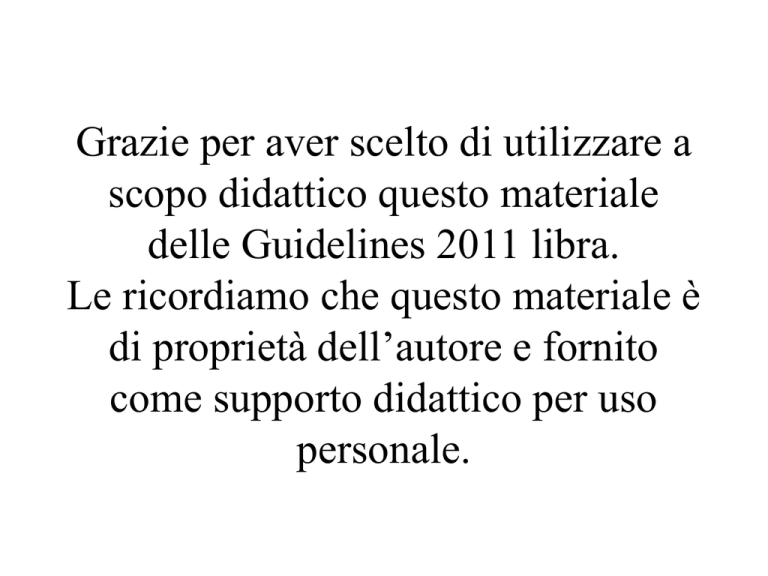
Grazie per aver scelto di utilizzare a scopo didattico questo materiale delle Guidelines 2011 libra. Le ricordiamo che questo materiale è di proprietà dell’autore e fornito come supporto didattico per uso personale. Non-pharmacological approach to comorbidities in COPD Thierry.troosters@med.kuleuven.be Outline • Inactivity driving morbidity in COPD • Preventing morbidity by remaining active • Treating morbidity by becoming active Functional status in COPD 60 GOLD IV Mean 289 GOLD III Mean 365 GOLD II Mean 405 800 50 40 30 20 10 R 0.34 p < 0.01 (ECLIPSE) R 0.30 p < 0.01 (Leuven) 1000 6MWD (m) Percentage of patients (3x100%) Predicting Functional status 600 400 200 0 0 20 40 60 80 100 120 FEV1 (%pred) Agusti Respir Res 2010 UZ Leuven Rehab d-base 2010 Functional status in COPD Predicting Functional status partial R2 p QF (Nm.kg-1) 0.21 0.001 FEV1 (%pred) 0.11 0.001 PImax (cmH2O) 0.01 0.01 800 6MWD (m) N=496 R 0.53 p < 0.01 (Leuven) 1000 Factors associated to 6MWD 600 400 200 0 0.0 0.5 1.0 1.5 2.0 2.5 3.0 3.5 Quadr/Weight (Nm.kg-1) UZ Leuven Rehab d-base 2010 Functional status in COPD 150 QF (% pred) QF (% pred) 150 100 50 0 N=279 N=159 100 50 0 0 25 50 FEV1 (%pred) 75 COPD Cont Long term inactivity, driving morbidity Physical inactivity drives morbidity Steps.day-1 ( n ) 12000 10000 -36% -43% moderate PA 8000 6000 4000 2000 0 Ctrl Troosters Respir Med 2010 Watz AJRCCM 2008 I II III IV Long term inactivity, driving morbidity KU-Leuven Rainbow study (Undiagnosed COPD ) Moderate PA (min) 150 Early COPD Healthy NON smoking Age (Years) 64±6 Healthy EX smoker Gender (% Male) 90 Healthy Smoker 27.1±4.1 BMI (kg/m²) Pack Years 49±23 COPD smoker LAAC intake (%) 9 COPDI/IIEX GOLD (N)smoker 33/16 FEV1 (L) 2.61±0.58 FEV1 (%pred) 86±17 FEV1/FVC (%) 62±7 125 100 75 50 40 50 60 70 Age (yrs) 80 Smoking controls 60±8 62 26.6±4.0 34±21 0 Healthy controls 62±6 47 25.5±3.5 0 * ° † ° * 3.09±0.70 105±14 76±4 3.18±0.72 116±17 78±5 * ° * P Long term inactivity, driving morbidity KU-Leuven Rainbow study (Undiagnosed COPD ) Amount and Intensity of physical activity are important to maintain health Healthy NON smoking Moderate PA (min) 150 Healthy EX smoker 125 Healthy Smoker Physical activity should be considered as a COPD smoker ‘vital sign’ CDC Physical activity plan March 2010 100 COPD EX smoker 75 50 40 Haskell Circulation 2007 50 60 70 Age (yrs) 80 Inactivity a source of comorbidity? 4 3 QF (Nm/kg) QF (Nm/kg) 5 2 1 4 3 2 1 0 0 0 50 100 Walking time (min) 150 0 10 20 30 40 50 60 Moderate PA (min) 70 80 90 Inactivity a source of comorbidity? QF (Nm/kg) 4 3 2 1 0 0 50 100 150 Walking time (min) Wagner Respirology 2006 Inactivity and Morbidity Deconditioning Cardiovascular morbidity Insulin resistance Cancer (Colon/Breast/Lung) Arterial Hypertension Bone and joint disease (Osteoporosis Arthritis) Depression Inactivity and Morbidity Comorbidity (%) 36 13 23 5 - 9 15 6 - Mapel Arch Intern Med 2000 22 65 45 12 - 17 32 18 - Soriano Chest 2005 28 22 - - - 10 26 4 - - 18 18 2 9 - - - - Walsh ATS 2006 70 50 52 16 16 38 62 4 32 Van Manen J Clin Epidemiol 2001 Sidney Chest 2005 Chatila PATS 2008 Comorbidity in COPD: physical (in)-activity COPD Symptoms (Dyspnea) Airflow obstruction Dynamic hyperinflation Age, gender, socialsuport, socioeconomicstate, educationallevel Barriers (symptoms) Anxiety Exercise capacity Physical (in-)activity (behavior) Self-efficacy Health beliefs COMORBIDITY Hematological abnormalities Inflammation Exacerbations Cardiovascular morbidity Pulmonary hyertension Osteoporosis Inflammation Mortality Muscle dysfunction Steroids Oxidativestress Exacerbations Endocrine dysfunction Steroids Exacerbations Sleep-disordered Breathing Mental state Hypoxia Preventing morbidity by PA? • No long term prospective data in COPD • Epidemiological suggestions • Data in other diseases (e.g. diabetes) Mortality (Probability Survival) Preventing morbidity by PA? 1.0 0.75 Tio Control SFC Placebo 14.9% 16.5% 12.6% 15.2% 0.50 High Average Low 0.25 Very low: Mainly sitting work, no PA in leisure time Low: < 2h/week low intensity physical activity 0.0 0 5 10 15 Very Low 20 Time (Years) Garcia-Aymerich Thorax 2006 Preventing morbidity by PA? Metformin 850mg Bid Incidence Diabetes -1 Placebo 7.5 5.0 2.5 40 (cumm %) 10.0 (MET-hr.wk ) Physical activity Intensive lifestyle int. 30 20 10 0 0.0 0 1 2 Time (Yrs) 3 4 0 1 2 3 4 Time (Yrs) All groups received standard package of guidelines regarding healthy life style (written and annual session of 30') Intensive life style = 16 face to face sessions followed by monthly session Knowler NEJM 2002 Preventing morbidity by PA? How could this be achieved in COPD? Raise awareness in milder patients Assess Physical activity Provide feedback on PA levels Discuss this with your patients 8000 7500 7000 6500 FEV1 TLC Age FB - R (n=18) UC - R (n=17) 67 ± 17 112 ± 20 63 ± 8 62 ± 14 114 ± 14 61 ± 9 6000 5500 5000 4500 4000 Feedback UC Hospes Patient Educ Counsel 2008 Treating co-morbidity by exercise training? Exercise tolerance: Weighted mean difference and IQR 110 100 90 80 70 60 50 40 30 20 10 0 20 10 0 Wmax VO2max Walking (% baseline) (% baseline) 30 Whole body end Adapted fromTroosters AJRCCM 2005 Treating co-morbidity by exercise training? Rehabilitation has a clear effect on Quadr 80 QF (Nm) 60 HRQoL and symptoms Exercise tolerance 40 20 0 Skeletal muscle weakness Depressed mood status -20 -40 -60 Exacerbations St ee C le or 20 on 03 ad o 20 M 03 er Se ken 20 w el 05 l2 00 Se 5 w ( el l 2 S) de 00 Bl 5 o k de 20 (I) Bl ok 06 20 (C) 06 (C St P) ee le Pi tta 20 08 20 0 Pi tta 8 (3 M 20 08 ) (6 W M al ) ke r2 00 D al 8 la s 20 09 Physical activity (% change) Rehabilitation has the potential to improve PA 70 60 50 40 30 20 10 Weighted mean +17% 0 Troosters Eur Respir Rev 2010 Rehabilitation impact on comorbidity? Exercise training and Arterial Stiffness, marker of CV risk PRE POST Pulse Wave Velosity (m.s-1) 12 N=10 4 weeks of PR 5d/week Endurance training 11 * 10 9 8 7 6 Controls TR Vivodtzef Chest 2010 Rehabilitation impact on comorbidity? Exercise training and Arterial Stiffness, marker of CV risk PRE POST Pulse Wave Velosity (m.s-1) 12 11 * 10 9 8 7 6 Controls TR Vivodtzef Chest 2010 Rehabilitation impact on comorbidity? Heart Transplantation N=8/8 0 CO TR 0 N=6/10 -5 -5 ** -15 -20 -20 +2 m th +8 m on th on +2 m Mitchel Transplantation 2003 +8 m -15 on th s -10 s -10 on th s ** s L2-L3 Bone mineral density (% change vs pre TX) Lung Transplantation Calcitonin Cal. + TR Braith Transplantation 2006 Do co-morbidities complicate rehabilitation? Crisafulli ERJ 2010 Do co-morbidities complicate rehabilitation? Proportion of patients with clinical benefit Exercise training yields significant effects, also in patients with comorbidity Crisafulli ERJ 2010 Summary • Comorbidity in COPD is at least partially driven by physical inactivity • BESIDES SMOKING CESSATION, early interventions aiming at keeping patients active could potentially prevent comorbidity • Exercise training as a stimulus may treat some comorbidity (muscle weakness, vascular, type II diabetes, osteoporosis, depression) • Patients with comorbidities are good candidates for exercise training
